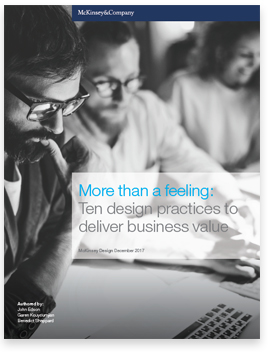Amazon Prime. The Apple iPhone. Netflix. Tesla. For those companies that get design right, the prizes are rich. The S&P 500 companies that invested most into design processes, capabilities, and leadership over the past decade, including design stalwarts such as Disney, Nike, and P&G, outperformed the rest of the index by 211 percent.
The importance of design is only increasing (see sidebar, “What is design?”). Consumers have instant access to global marketplaces and ever-higher expectations of service. They no longer distinguish between physical and digital experiences. This makes it increasingly difficult to make your product or service stand out from the crowd. As a result, design has become a CEO-level topic for many executives.
But while the concept of “design thinking” emerged as far back as 1969, and while many companies have tried to adopt its principles, relatively few have made true shifts in growth and profitability through design. Fewer still have been able to prove concretely the exact value of the design actions they’ve taken.
We have begun to explore the underlying design practices that allow some firms to succeed above others. Our research into global companies across multiple industries aims to uncover the connections between business value and design. Our early findings, presented in this article, are not yet statistically significant; we will continue to expand our data set in 2018 to reach that goal. But already some trends are evident. We see ten design actions across three themes that appear to correlate with improved financial performance.
First, for these firms, design is more than a department. Design-led companies are structured in ways that encourage all functions to focus on their customers. This generally means that design is not a single department; rather, design experts are everywhere, working within small, cross-functional teams with shared incentives and regular customer interaction.
Second, design is more than a phase. Good design-led companies use quantitative and qualitative research during early product development, combining techniques such as warranty-data analysis, social-media scraping, focus groups, and ethnographic research to better understand their customers’ needs. However, the best companies continue listening and iterating long after the initial conceptual phase, remaining invested in improving customer experiences postlaunch.
Finally, successful design-led companies don’t act on gut alone. For them, design is more than a feeling. They measure and manage design as rigorously as they do cost, quality, and time. Design strength is a C-level metric, and the head of design stands shoulder to shoulder with the heads of sales, operations, and finance. [p. 2]
This report explores the underlying design practices that allow some firms to succeed above others across multiple industries. Aiming to uncover the connections between business value and design, the report identifies ten design actions across three themes that appear to correlate with improved performance. Amazon Prime, Apple, Netflix, Tesla are among the companies that get design right.


Most Commented